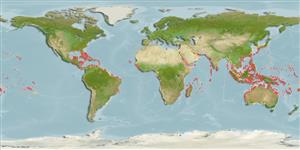Classification / Names
Common names from other countries
Main reference
Size / Weight / Age
Max length : 150 cm TL male/unsexed; (Ref. 30573); common length : 90.0 cm SL male/unsexed; (Ref. 9682); max. published weight: 6.4 kg (Ref. 40637)
Environment
Marine; reef-associated; oceanodromous (Ref. 51243); depth range 0 - 13 m (Ref. 58302)
Climate / Range
Tropical; 26°C - 29°C (Ref. 4959), preferred 28°C (Ref. 107945); 21°N - 1°N
Distribution
Indo-West Pacific: Red Sea and South Africa (Ref. 5317) and Persian Gulf (Ref. 68964) to French Polynesia (Ref. 6784), north to Japan (Ref. 559), south to New South Wales, Australia (Ref. 33390). Replaced by Tylosurus crocodilus fodiator in the eastern Pacific. Western Atlantic: New Jersey, USA to Brazil (Ref. 7251). Eastern Atlantic: Fernando Poo, Cameroon, Liberia, and Ascension Island (Ref. 5757); from Senegal and Guinea (Ref. 28587); and Cape Verde (Ref. 27000). Recorded from the Mediterranean Sea (Ref. 83387).
Countries | FAO areas | Ecosystems | Occurrences | Introductions
Short description
Dorsal
spines
(total): 0;
Dorsal
soft rays
(total): 21-23;
Anal
spines: 0;
Anal
soft rays: 18 - 22;
Vertebrae: 80 - 86. Diagnosis: body elongate; upper and lower jaws extremely long, forming a stout beak armed with very sharp teeth; gill rakers absent (Ref. 57228, 90102). Nostrils in depression before eyes (nasal pit); pelvic fins abdominal; 21-23 dorsal-fin rays; anal fin long, 5.5-8.0 times in body length; small, black lateral keel on either sides of caudal peduncle; caudal fin deeply forked (Ref. 57228).
IUCN Red List Status (Ref. 115185)
Threat to humans
Traumatogenic (Ref. 4690)
Human uses
Fisheries: commercial; gamefish: yes
More information
ReferencesAquacultureAquaculture profileStrainsGeneticsAllele frequenciesHeritabilityDiseasesProcessingMass conversion
Tools
Special reports
Download XML
Internet sources
Estimates of some properties based on models
Phylogenetic diversity index
PD50 = 0.5078 many relatives (e.g. carps) 0.5 - 2.0 few relatives (e.g. lungfishes)
Trophic Level
4.4 ±0.4 se; Based on diet studies.
Resilience
Low, minimum population doubling time 4.5 - 14 years (Preliminary K or Fecundity.)
Vulnerability
High to very high vulnerability (69 of 100)
Price category
